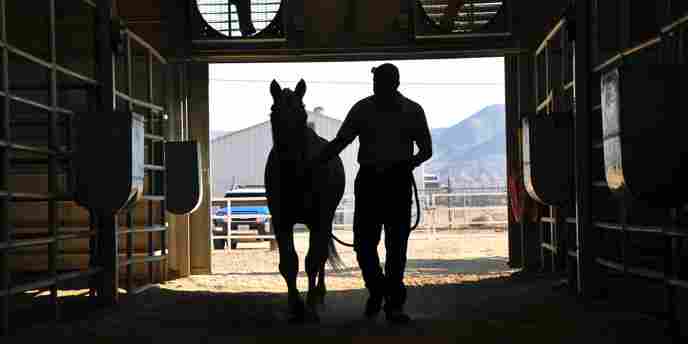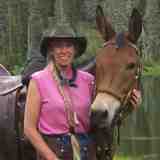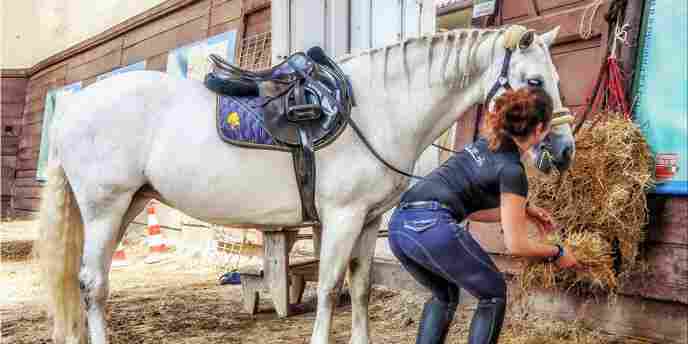If you’ve decided to take on the Chip and Joanna Gaines rural farm lifestyle – horses and all – it’s important to keep in mind a few horse barn maintenance tips as a beginner. “A healthy horse means a happy owner,” says Kim Houlding of the Iowa Horse Council.
A well-maintained horse barn can “prevent physical accidents, prevent fires, provide disease and parasite control, and help you save on veterinary bills,” says Houlding. To keep your new animals thriving for years to come, add these nine maintenance tips to your barn chores checklist.
9 Barn Maintenance Tips to Keep Your Horses Happy and Healthy

1. Keep the Barn Well-Ventilated
To protect your animals’ health, make sure your horse barn chore checklist includes regular airflow checks and ventilation maintenance. The key is to move moist, dust-laden air out of the barn to prevent mold and respiratory problems for your horses.
How to Keep a Barn Well-Ventilated
Cleaning horse stalls properly is another important tip for sustaining good air quality for your animals, as it prevents ammonia buildup.
2. Pest Proof Your Barn
The warm hay and plentiful grain of horse barns is practically an open invitation to rodents and other animals. Having rats in the barn can bring fleas, disease and structural damage to your livestock’s living space. Cleaning your horses’ stalls, having good stable organization and using rodent-proof containers for their feed are important for keeping rats and mice at bay.
But if the critters have already made your horses’ home their own, here are a few tips for getting them out for good:
How to Get Rid of Rats in the Barn
3. Store Saddles Correctly to Protect Your Horse’s Back
Saddles are big investments, making their care an important part of horse barn maintenance. They need to be stored properly to keep your four-legged friends safe during rides, says Terri Beecher of Out West Saddlery:
“You can torture your horse’s back with a bad or damaged saddle. That’s why when storing a saddle, you don’t want to keep it anywhere hot like a trailer, especially if using a saddle tree stand. The heat can warp the shape, which can harm the horse’s back when you try to ride with it.”
 “You can torture your horse’s back with a bad or damaged saddle. That’s why when storing a saddle, you don’t want to keep it anywhere hot like a trailer, especially if using a saddle tree stand. The heat can warp the shape, which can harm the horse’s back when you try to ride with it.”
“You can torture your horse’s back with a bad or damaged saddle. That’s why when storing a saddle, you don’t want to keep it anywhere hot like a trailer, especially if using a saddle tree stand. The heat can warp the shape, which can harm the horse’s back when you try to ride with it.”Terri Beecher| Out West Saddlery
Tips for Proper Saddle Storage in the Barn

4. Improve Your Hay and Horse Feed Storage
Stable organization is crucial for good barn maintenance, as horse feed and hay can go bad if stored improperly. Not to mention that some horses may take an unsecured feed bin as an open buffet invitation. To protect your horses’ food supplies from the elements and themselves, here are some tips for proper feed storage in your horse barn:
Horse Feed Storage Ideas
While horses shouldn’t have unlimited access to grains, they do need regular access to hay and grass to stay healthy, as Beecher explains:
“Horses release stomach acid 24/7, whereas humans only do so while we’re eating. They normally graze close to 20 out of 24 hours of the day, and need to do so to prevent ulcers and anxiety. I’m a huge advocate of free feeding from slow feed hay nets. You can hang them high up in trees or around the barn. This will allow access while preventing hay from getting dirty on the ground.”
Terri Beecher | Out West Saddlery
5. Keep Barn Stalls Clean and Dry
Cleaning horse stalls and keeping them moisture-free is important for good horse barn maintenance. Stall cleanings are a must for daily barn chore checklists, as a wet or dirty horse stall can present a slipping hazard and introduce disease and bacteria into your barn.
In addition to keeping your animals healthy, regular cleanings and maintenance can protect wooden horse stalls from wood rot, insects and mold growth in the long run.
Horse Stall Cleaning Tools
How to Clean a Horse Stall
Horse stalls should be mucked out at least once a day and no less than six times a week. We asked the Iowa Horse Council for a list of other recurring tasks on barn chore checklists:
Barn Chore Checklists:
| Daily Barn Maintenance Tasks | Weekly Barn Maintenance Tasks | Annual or Semi-Annual Barn Maintenance Tasks |
|
|
|
Kim Houlding | Iowa Horse Council
6. Check for Safety Hazards During Horse Stall Maintenance
“Horses could hurt themselves even in a padded room,” says Beecher. That’s why keeping stalls free from potential hazards should be at the top of your barn chores checklist at all times. In order to keep them contained safely, here are a few safety hazards to check for when cleaning your horse stalls.
Horse Stall Safety Hazards Checklist
“[For additional safety,] I also like to have tongue and groove walls in stalls or an anti-cast strip installed so that a horse that lays down too close to the wall can get its feet underneath of something to push off and get himself up. Also, electric sockets need to have covers if they are near a stall door or gate and should never be too close to water outlets.”
Karen Tappenden | Holistic Horse
7. Opt for a Safe, Low-Maintenance Barn Floor Option
Speaking of barn maintenance tips for safety, your barn floor should also be a top priority. Old, poorly maintained floors can be unsafe for your animals to walk on. If your barn floors are worn or eroded beyond repair, you may want to replace it with an easy-to-maintain barn floor option.
“I would look at a grid system for the floor that is filled with gravel so the floor drains and the gravel is not dug out with the mucking. I had it in a 3-stall barn and worked in a 30-stall barn. I never had any slipping issues and the stalls were much easier to maintain.”
Karen Tappenden | Holistic Horse
More Low-Maintenance Barn Floor Options
For concrete and asphalt floors, it’s important to use plenty of bedding and rubber mats to protect your horses from hock, elbow and fetlock sores.
8. Invest in Barn Roof Repair and Maintenance
Barn roofs keep your hooved friends (and everything that comes with them) safe from the elements, so it’s important to perform routine maintenance checks to ensure they’re in working condition.
Barn Roof Repair and Maintenance Checklist
9. Keep Bugs Out (Safely)
From flies to termites, bug control is a must-have on horse owners’ barn chore checklists, but it’s important to use horse-friendly repellents to do it. “Most fly sprays are chemical poisons, which horses can absorb into their skin,” says Beecher. “I like to switch back and forth between Natural Fly Spray and Flicks, both economical, natural fly sprays to use in the barn.”
Dry wood termites can spell disaster for wooden barns, so it’s also crucial to include annual termite checks in your horse barn maintenance routine. Your local pest control company can help you find animal-friendly pre-treatments for horse stalls to safely keep wood-hungry nuisances at bay.
The Best Barn Maintenance Tip? Keep an Eye on Your Horses
Horse barn maintenance routines may differ slightly from owner to owner, but the easiest way to tell if your hard work is paying off is to pay attention – to your horses, that is. “It’s good to look at your animals and make sure they’re not sick or injured on a regular basis,” says Beecher. “People think that horses are like motorcycles but they’re not. They’re living, breathing, sensitive and amazing animals that are also a big commitment.”
If you start noticing changes in your horse’s appearance or behavior, take a closer look at their surroundings. Is their bedding deep enough? Do they have enough space in their stall? Is their food fresh and dry? Understanding your animals and their individual needs is the key to keeping a happy and healthy horse barn.
Looking for more animal-friendly improvements around your home? Check out our post on Dog-Friendly Landscaping Ideas for Your Backyard .
